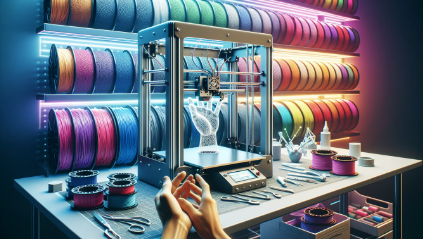Understanding the Basics of 3D Printing in Any Industry
Unlock the full potential of your 3D printer with our comprehensive guide to maintenance. Whether you’re in the industry, medical, or dental sector, ensuring your 3D printer is in top-notch condition will save you time, money, and hassle. This guide walks you through essential steps, offering tailored advice for different sectors to boost your 3D printing experiences.
Understanding Your 3D Printer
Before diving into maintenance, it’s crucial to understand the basics of your 3D printer. Familiarize yourself with the core components such as the print bed, nozzle, and filament type. Each part plays a significant role in the printing process and requires specific care techniques. Awareness of your printer’s build and functions will simplify troubleshooting and routine upkeep.
Step-by-Step Maintenance Guide
1. Regular Cleaning
A clean printer is a happy printer. Dust and debris can affect print quality and lead to mechanical issues. Incorporate these cleaning practices:
- Nozzle Cleaning: Use a needle or nozzle-cleaning kit to remove filament clogs.
- Print Bed Maintenance: Ensure the print bed is free from leftover materials. Alcohol wipes can be used for a thorough clean.
- Exterior Dusting: Regularly wipe down the exterior with a microfiber cloth.
2. Inspection and Calibration
Consistent inspection and calibration are vital for maintaining accuracy. Here’s how to keep your printer aligned:
- Level the Bed: Use a leveling tool or follow the manufacturer’s instructions to ensure a flat surface.
- Check Belt Tension: Loose belts can cause layer shifting. Tighten them as necessary.
- Calibrate the Extruder: Ensure that the extruder dispenses the right amount of filament by recalibrating regularly.
3. Lubrication
Maintain the longevity of your printer by ensuring moving parts are well-lubricated. Apply lubricant to rods and bearings to reduce wear and tear. Always use products recommended by your printer’s manufacturer.
4. Software Updates
Keeping your software up-to-date is crucial for security and performance enhancements. Regularly check for updates for your 3D printing software such as 3D Sprint, Geomagic, and exocad for optimal function and access to new features.
Industry-Specific Tips for 3D Printing
For the Manufacturing Industry
Manufacturers frequently leverage 3D printing for rapid prototyping, custom tooling, and even end-use part production. To ensure optimal efficiency and high-quality results, consider the following best practices:
- Consistent Material Supply: Material quality directly impacts print durability and accuracy. Establish relationships with reliable suppliers and maintain a stock of consistent, high-quality filaments or resins to avoid defects.
- Software Updates & Optimization: As 3D printing technology evolves, software updates can introduce new slicing algorithms, enhanced support structures, and better material profiles. Regularly updating your software ensures compatibility with complex geometries and improves print efficiency.
- Post-Processing Techniques: Depending on the application, manufacturing parts may require additional sanding, painting, or coating. Implement post-processing strategies that align with your industry standards for smoothness, strength, and functionality.
- Environmental Control: For metal 3D printing or high-performance polymers, maintaining a controlled environment—temperature, humidity, and ventilation—helps prevent warping and ensures consistent layer adhesion.
- Testing & Iteration: Prototyping involves rapid iteration. Structured testing protocols, such as mechanical stress testing or thermal analysis, are used to validate parts before mass production.
For the Medical Sector
3D printing in the medical industry revolutionizes custom prosthetics, anatomical models, implants, and bioprinting. Since accuracy and patient safety are critical, maintaining strict quality control is necessary:
- Precision Through Calibration: Micron-level accuracy is essential for printing surgical models or patient-specific devices. Frequent calibration of print beds, nozzles, and lasers ensures dimensional accuracy.
- Sterilization Protocols: Any object used in a medical setting must be free from contaminants. Before use in clinical settings, prints must be sterilized using autoclaves, UV sterilization, or chemical treatments to ensure they meet hygiene standards.
- Medical-Grade Materials: Only use biocompatible resins, FDA-approved polymers, or titanium alloys designed for direct patient use. Different applications, such as implants vs. training models, require specific material properties.
- Regulatory Compliance: Stay up-to-date with FDA, ISO, or CE regulations regarding medical device manufacturing, as 3D printing is subject to strict safety and effectiveness standards.
For the Dental Industry
3D printing has transformed dentistry, orthodontics, and prosthodontics by enabling the fast production of crowns, bridges, aligners, and models. Given the intricate details required, maintaining equipment and materials is crucial:
- Frequent Inspection of Components: Dental 3D printers handle fine-detail printing, making components like resin vats, print heads, and curing units prone to wear over time. Regular maintenance and timely replacement of these parts prevent misprints.
- Specialized Printing Materials: Dental applications require materials that offer high strength, biocompatibility, and precision. Use dental resins, zirconia-based ceramics, and FDA-approved polymers designed for intraoral use.
- Accuracy & Fit Testing: Orthodontic devices and prosthetics must fit precisely. Post-processing techniques, such as light curing and polishing, help refine surface smoothness for better patient comfort and durability.
- Optimized Print Settings: Fine resolution (e.g., 50-micron layer height) ensures smooth surfaces on dental models, reducing the need for excessive post-processing.
- In-House vs. Outsourced Printing: While many dental labs use in-house 3D printing, some clinics prefer outsourcing to specialized dental printing services. Choosing the right approach depends on volume, cost, and expertise.
By implementing these industry-specific best practices, businesses can enhance the quality, efficiency, and reliability of their 3D printing applications. Whether in manufacturing, medicine, or dentistry, maintaining rigorous quality control and leveraging the latest advancements will ensure long-term success.
By following this dedicated guide, you’ll extend the life of your leased 3D printer and enhance its productivity. For further assistance, consult with Nota3D for expert advice and support tailored to your industry needs.
